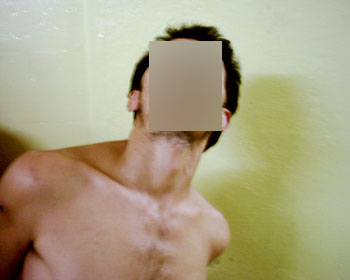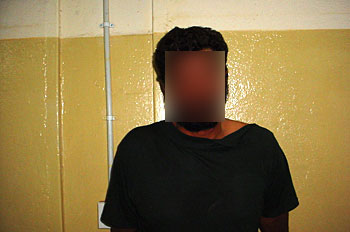Note: Ignoring the pink elephant in the room, I have previously avoided talking about Abu Ghraib. What could I add to a topic so exhaustively dissected? However, after listening to Philip Gourevitch speak at a local bookstore I am urged to write.
Mention ‘Prison’ and ‘Photography’ and the collective conscience defaults to the Abu Ghraib pictures. There is no escaping this fact as there is no escaping those images. The Abu Ghraib photographs inform and corrupt key dialogues of our global society – war & power; geopolitics & the psychology of surveillance; Iraq & imperialism; Western & Islamic relations; and military operations & media-constructed otherness. Add to that list, uncomplicated human cruelty.




Those images have seeped into more spheres of conscious and sub-conscious thought than the most successful of photojournalist essays. This is emergence and pre-eminence of the Abu Ghraib photographs as the most current strongest visual “player”. Former strongest players have included Robert Capa’s images of the Normandy Invasion; or (Nick) Huỳnh Công Út’s photograph of Kim Phuc running from a napalm attack on Trang Bang, Vietnam; or Eddie Adams’ photograph of police chief General Nguyễn Ngọc Loan executing a Vietcong prisoner, Nguyễn Văn Lém. As Gourevitch said, “If a photojournalist had taken those [Abu Ghraib] images he or she would have been celebrated and decorated for their public service.”
Those photographs are many things. They are evidence of a corrupted system bereft of accountability. They are the most important images of the War on Iraq. When recollected, they should never be separated from the exacting malevolence of the Rumsfeld Department of Defense. They are already established as the most commonly shared images of global culture. The hooded prisoner is a 21st century icon. Perhaps, partly, this is why Americans rallied to make an immediate icon of Obama; to purge a nation’s collective visual memory, and to replace negative, shameful images with positive, hopeful, primary-coloured pop-motifs.




Gourevitch talked about the craft of the interview. The Paris Review, which he has edited since 2005, recently released the third of a four volume anthology of interviews with 20th century writers. Gourevitch noted the simplicity of the method and pointed out that in 1953 when the Paris Review was founded, no publications were interviewing writers. Literary criticism had become high brow and, to many, obsolete; it talked about the text but never the artist. The Paris Review was the first legitimate peek into the private lives, motivations and pathologies of poets and authors. Fellow writers could scrutinise every spoken word and omitted detail of their contemporaries. The Paris Review, in its early days, served as the exposé – the gossip column – for the literary world.
For fifty years, until his death in 2003, George Plimpton was editor of the Paris Review. It is fitting that Plimpton’s large shoes should be filled by a writer and journalist who has made an art form of the interview. Gourevitch’s acclaimed book We Wish to Inform You That Tomorrow We Will Be Killed With Our Families was based on information gleaned from an unhurried, matter-of-fact tour of Rwanda where he simply talked to people. Rwandans didn’t have their own journalists clearing the way for testimony in the immediate aftermath of the genocide and Gourevitch found support for his theory that “All people need to talk”. He described Rwandans culturally as the opposite of effusive, but maintained this didn’t mean they were unwilling to share their experiences.




For Standard Operating Procedure, accompanying the profound Errol Morris movie (which has unsurprisingly suffered stymied distribution in the US), Gourevitch sat in on 100 hours of Morris’ questions (approximately half of Morris’ interviews).
Following Gourevitch’s presentation, I asked him if there were any atypical motivations for the American servicemen and servicewomen agreeing to the interview process. Was there any information they were keen to convey? Gourevitch was quite clear. There was a single shared motivation for Sabrina Harman, Lynndie England and colleagues. The interviews are one long exercise in self-representation. Prior, the soldiers had been silenced, criminalised and later written off as “bad apples” by a military narrative designed to shield the senior accountable authorities. The media was partly complicit and the soldiers “were pissed off”, stated Gourevitch.
From the moment the US military command learnt of the pictures, the soldier/guards of Abu Ghraib were set up for the fall. The military sequestered the reservists away and lined up a raft of charges for each soldier. The US military sat on those charges hoping that if it could retrieve and control the images, it wouldn’t have to bring the matter to public attention through trial. The US military visited homes of the soldiers’ family members back in the US. They demanded computers and deleted files. After some time, it was clearly apparent to the families of the Abu Ghraib soldiers that their sons and daughters were being made scapegoats. An exact single source of the images has never been pinned down, but Gourevitch contends it was a disgruntled family member who finally unleashed the digital photographs to a world swiftly buying into the prevailing Department of Defense narrative.
We Have Seen Their Actions, Let’s Hear Their Words
The Abu Ghraib photographs can and should be understood only in the context of their production, which is to say, by a group of individuals trained as soldiers and ordered to guard prisoners in a decrepit facility; by photographers who were compelled to document precisely because they couldn’t comprehend the atrocities; by a group of soldiers influenced and hardened by one another; by a group of soldiers under no direct or pre-written guidelines; by a group of soldiers with complex thoughts, manipulations and haunted memories. Morris did us a public service with his movie and it is fitting that the accompanying book by Gourevitch features no images.
Of course, what the global community needs now is an equally comprehensive documentary project bringing together the testimonies of all those held and tortured at Abu Ghraib.
Note: I wanted to avoid resorting to the common and most shocking images of Abu Ghraib that we’ve seen so often – box, blanket, hood, wires, scrotum, pyramid, puddles, dogs, blood, shit, thumbs, leash, limbs, body bag – and I don’t exactly know why. Salon put together a responsible collection of all 291 Abu Ghraib images if you need to put those infamous images back into the context of the prison facility.
The Artistic Legacy of Abu Ghraib
Ridiculously, artists that have chosen to reflect the systematic abuses at Abu Ghraib have come under fire.
Clinton Fein’s ingenious reconstructions of the Abu Ghraib crimes drew criticism for many selfish reasons (an unwelcome return to problematic images despite their obvious construction, a project of a sadist, a re-opening of a cultural wound?). The intelligence of Fein’s project was that it challenged our premature numbness to the original Abu Ghraib photographs and forced a renewed pathos toward a subject that we’d never known anyway. Are we supposed to feel something toward Fein’s models?

Colombian painter Fernando Botero gestures front of his new paintings depicting the horrors of U.S. guards’ abuse of captives at Iraq’s Abu Ghraib prison, Monday April 11, 2005 in Paris, France. Botero says he became so upset that he felt compelled to produce works showing his trademark chubby characters naked and being blooded by Americans. (AP Photo/Francois Mori)
Fernando Botero‘s work has won plaudits around the US. I think his work is excellent for many obvious reasons, so don’t call me a cynic when I say Botero’s work is more easily accepted because his Beryl Cook cherub-grotesque style, and the fact he is a Latin American commenting on a war to which Latin America remained external. Put another way, he serves up the shit sandwich with relish, whereas Fein left it in the bowl. Here’s an official presentation, here’s Berkeley enjoying the show and here’s the AP writing about it before it caravanned around America.
And finally, Chris Bartlett (Photographer) and Daniel Heyman (Painter) have teamed up to produce the Detainee Project which creates portraits of individuals illegally detained throughout America’s war on Iraq. George Soros helped Bartlett give detainees dignity and representations beyond hoods, nudity and dogs.














